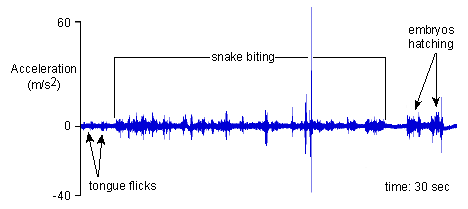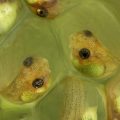Stuck to a leaf like a blob of jam, the gelatinous egg clutch of the red-eyed treefrog (Agalychnis calidryas) of Central America is a food favored by arboreal snakes. Five minutes is all it takes for a snake to gobble down a clutch of a few dozen frog eggs. Yet, as their unhatched siblings are being devoured, some of the red-eyed treefrog embryos can sense the vibrations of the snake’s feasting and hatch prematurely. Squirming and wriggling the tadpoles escape by dropping from the leaf and into a pond below.
Recently, researchers from Boston University and the Smithsonian Tropical Research Institute (STRI) in Panama have been taking a closer look at the vibrations that red-eyed treefrog embryos use as cues to trigger early hatching. The researchers—Michael Caldwell and J. Gregory McDaniel of Boston University and Karen Warkentin of both Boston University and STRI—embedded tiny recording devices into red-eyed treefrog egg clutches and recorded the low-frequency vibrations caused by snakes as they ate the eggs and also by tropical rain storms. They played back these vibrations to egg clutches in a laboratory and found the embryos hatched in response to the snake-generated vibrations and not to the rain vibrations.
This experiment showed that the embryos were responding to the vibrations and didn’t need chemical or visual cues from snakes, Warkentin says, and that the embryos could differentiate between snake vibrations and rainstorm vibrations.
What puzzled the researchers was that the low-frequency vibrations that triggered the embryo hatchings were in some ways very similar to vibrations caused by many benign forest stimuli—such as rainfall, wind or non-predatory animals. “Hatching early in response to benign stimuli would be a serious error” Warkentin explains, “since premature hatchlings are vulnerable to predators in the pond. We reasoned that if a defense—such as hatching early—is costly for prey, then mechanisms should be in place to avoid false alarms, just as mechanisms exist to recognize and defend against predators.”

Photo: The device in this egg clutch is an accelerometer, used to record vibrations. The vibration recording from a snake attack on an egg clutch is shown below.
In recent laboratory work the scientists improved their understanding of how these false alarm mechanisms work in regard to rainfall. The low-frequency vibrations generated by tropical rainstorms are accompanied by two elements that snake-feeding vibrations do not have: high frequency vibrations and an initial buildup of intensity. When these two features were removed from rainfall recordings and the edited recordings were played back to embryos in the lab, many of the embryos hatched. The intensity buildup and high frequency vibrations played simultaneously with low frequency vibrations indicative of danger suppressed the hatching response.
“Although we don’t know the precise mechanism—whether, for instance, the high-frequency vibrations mask perception of the low-frequency vibrations that indicate danger, or whether the embryos perceive high frequency vibrations as indicative of safety—we do know that the embryo behavior is affected by these two features of rain vibrations in a way that benefits them,” Warkentin says.
A paper on this research: “Is it safe? Red-eyed treefrog embryos assessing predation risk use two features of rain vibrations to avoid false alarms,” was published in the journal Animal Behavior at the Web address: www.elsevier.com/locate/anbehav
The Web site for the Warkentin Lab at Boston University is: people.bu.edu/kwarken/
—John Barrat








